Top 13 Weirdest Phobias That Really Do Exist
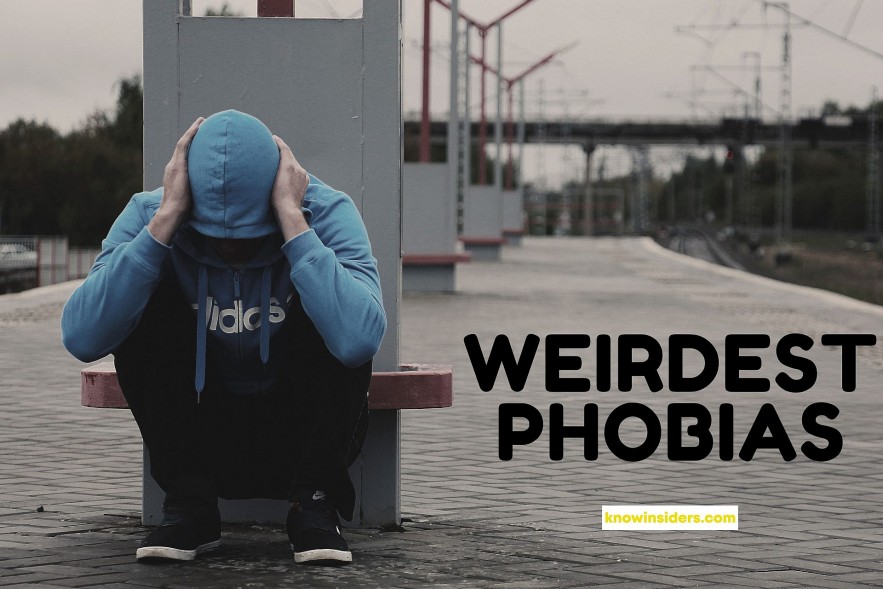 |
| Top 13 Weirdest Phobias That Really Do Exist. Photo KnowInsiders |
| Table of Contents |
What is a phobia?
If you have strong anxiety and feelings of panic around certain objects or situations, it could be caused by a phobia.
Feeling fearful or anxious can be normal and even helpful. But when the fear is overwhelming and disproportionate to the actual threat, we move into the territory of phobias.
Have you ever wondered how you get a phobia?Sometimes a traumatic event can cause one such as nearly falling off a high ledge. They can also be learned – like picking up a fear of flying from listening to a parent swear they’ll never fly again after a bad experience. But, what if you’ve never actually had a traumatic public speaking experience, but the very thought of public speaking still makes you struggle to catch a breath? Where does this come from? As crazy as it sounds, experts say this could come down to an experience one of your ancestors had, which has been passed down in our DNA. So if an ancestor was once laughed off a stage and then developed a public speaking phobia, research suggests this could be passed down for generations to come. |
How many types of phobias existing?
You can have a phobia of pretty much anything, but there are over 400 recognised phobias out there!
Some, however, are much more common than others.
Phobias such as a fear of heights (acrophobia), fear of flying (aviophobia), fear of enclosed spaces (claustrophobia), fear of spiders (arachnophobia), fear of snakes (ophidiophobia), fear of dogs (cynophobia), fear of needles (trypanophobia) and the fear of germs (mysophobia) are all pretty common.
A phobia and a fear: different or the same?
You’d probably feel a bit scared and panicked if you saw a big hairy spider climbing up your wall or wobbly if you were standing on a high ledge. But this doesn’t necessarily mean you have a spider or height phobia.
Although it doesn’t feel very nice, fear and some level of anxiety are ‘normal’ emotional responses to either a real or perceived threat.
A specific phobia, on the other hand, is an overwhelming fear of objects or situations.
For example, if someone has a spider phobia, they might do everything they can to avoid spiders and it can even start to consume their life.
They may spend huge amounts of time thinking and worrying about spiders and avoiding places and activities where spiders might be, like the bush or walking outside at night.
READ MORE: Top 9 Common Phobias in the World
Top 13 Weirdest Phobias That Really Do Exist
1. Cacophobia: Fear Of Ugliness
Cacophobia is an overwhelming and irrational fear of ugliness. A person who suffers from this phobia is not just afraid of ugly people—they also fear any object or situation they perceive as ugly. Experts aren’t sure what triggers this phobia, though as with all phobias, it is likely caused by some traumatic event that the sufferer has come to associate with ugliness.
Common symptoms
Cacophobia is considered as an anxiety disorder due to the manifestations produced by the alteration.
When an individual with cacophobia exposes himself to his feared elements responds immediately with a series of Anxiety symptoms.
These symptoms are caused by the phobic fear of ugliness and generate a high discomfort in the individual.
Likewise, the symptomatology can seriously affect the functioning and behavior of the individual, limiting their quality of life and well-being.
Eager manifestations of cacophobia can be divided into: physical symptoms, cognitive symptoms and behavioral symptoms.
How to overcome
The first choice treatment for cacophobia is the psychotherapy , which has been shown to be much more effective intervention with drugs.
In this sense, cognitive behavioral treatment incorporates techniques and therapeutic tools that have proven to be very useful to reverse and overcome phobic fears.
The main interventions performed in this type of treatment are:
→ Exposure to the phobic element in a gradual way with the aim of getting used to it and learn to manage the feelings of fear.
→ Relaxation techniques To mitigate the impact of anxiety symptoms.
→ Cognitive techniques to modify irrational thoughts about ugliness.
2. Somniphobia: Fear Of Sleep
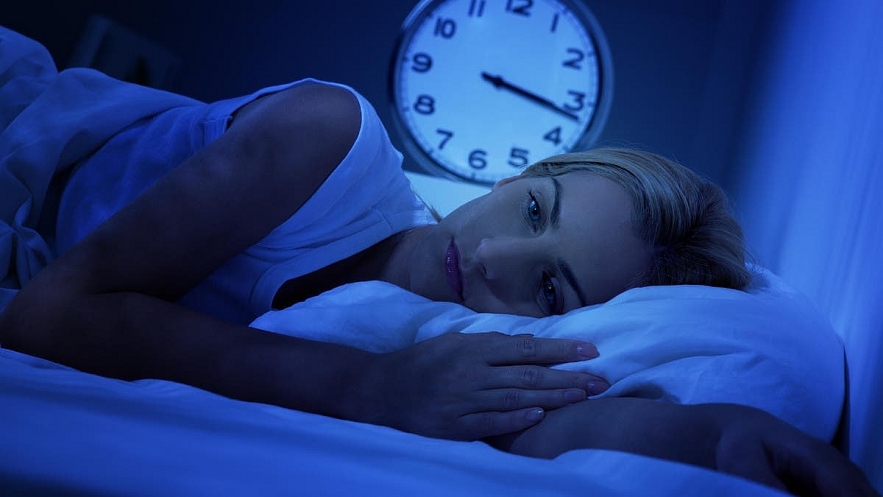 |
| Photo Al Arabiya |
Common symptoms
Mental health symptoms specific to somniphobia might include:
→ feeling fear and anxiety when thinking about sleeping
→ experiencing distress as it gets closer to bedtime
→ avoiding going to bed or staying up as long as possible
→ having panic attacks when it’s time to sleep
→ having trouble focusing on things besides sleep-related worry and fear
→ experiencing irritability or mood swings
→ having a hard time remembering things
Physical symptoms of somniphobia often include:
→ nausea or other stomach issues related to persistent anxiety around sleep
→ tightness in your chest and increased heart rate when thinking about sleep
→ sweating, chills, and hyperventilation or other trouble breathing when you think about sleeping
→ in children, crying, clinginess, and other resistance to bedtime, including not wanting caregivers to leave them alone
Treatment
If you notice that you are spending more and more time avoiding sleep, or if you experience extreme panic or anxiety when thinking about falling asleep, talk to your doctor. Ask for a referral to a mental health provider and set up an appointment to see them if your symptoms do not resolve with lifestyle changes or medical intervention.
Exposure therapy is one of solutions. In exposure therapy, you’ll work with a therapist to gradually expose yourself to your fear while working on ways to reduce fear and anxiety.
For somniphobia, exposure therapy may include discussing the fear, using relaxation techniques, and then imagining what it would be like to get a good night sleep.
Next, it may involve viewing images of people asleep who appear to be comfortably resting. Then, when you’ve mastered these cues, you may be encouraged to take brief naps — with a partner, parent, or trusted friend present in the house — to reinforce that you can wake up safely.
Myth: If you remember your dreams, it means you slept betterMany people believe that remembering their dreams means they had a good night's sleep. That's not necessarily the case, says Ariel Garten, co-founder of Muse, a neuroscience and meditation company. People actually remember dreams when they're woken up during them, she says, which indicates poorer sleep. It also has something to do with sleep stages: You're more easily woken up during REM sleep, which is when dreams happen, Garten says. |
3. Ablutophobia: Fear Of Washing And Bathing
Although many children are resistant to being washed, this condition is much less common in adults. However, for a rare few the thought of stepping under a shower is quite literally terrifying! The good news for ablutophobics is that skipping the occasional shower can help to preserve natural oils and good bacteria that protect your skin and help to prevent disease. However, making it a regular habit is unlikely to benefit either your health or social life.
Symptoms
- Hyperventilation
- Palpitations
- Trembling
- Sweating
- Dizziness
- Hot flashes or chills
- Numbness or tingling
- The sensation or fear of choking or nausea
- Depersonalization or derealization where the phobic no longer understands what is going on. They lose touch with reality and literally gets an ‘out of body’ like sensation.
- Fear of fainting
- Thoughts of death or dying
- Loss of control or fear of losing one’s mind
| Queen Elizabeth I of England once famously announced that she took a bath about once a month, ‘whether or not she needed it’. She wasn’t an Ablutophobe; in fact, she was one of the cleanest people in history. But bathing facilities just weren’t as commonplace then as they are today and in Europe many people still avoid bathing daily. There is a song by New Zealand artist, Sheep, Dog & Wolf, called Ablutophobia. In 2006, the play called ‘Mistakes Madeline Made’ depicted a character that developed Ablutophobia. Popular sitcom Friends featured the phobia in an episode titled ‘The One with Joey’s Dirty Day’. 24% Americans, in a 2014 survey, admitted to not washing their hands after using a public toilet. The fear of bathing or washing is more common in women and children than in adult men. |
How to overcome
In most phobias, exposure therapy helps. The phobic is gradually exposed to the object or situation he or she fears, in this case, water or bathing, in a safe and controlled manner. Naturally, Ablutophobes will not bathe while the therapist is present, so NLP and virtual reality exposure therapy can help.
4. Neophobia: Fear Of New Things
While many people are wary of change, neophobia is a phobia that refers to an intense and irrational fear of all new things and experiences. Neophobia can impact on happiness and wellbeing as sufferers miss out on many life-enhancing experiences. When applied to the diet it can also mean that sufferers miss out on various healthy foods and nutrients. Research has also shown that the stress of neophobia can shorten life expectancy.
Symptoms
Neophobia can lead to physical, psychological, and behavioral symptoms. Some of the physical symptoms of this type of phobia can include:
- Breathlessness
- Dizziness
- Increased heart rate
- Nausea
- Trembling
Psychological symptoms include feelings of anxiety, a sense of unreality, or a fear of dying. The physical and psychological responses that people experience when confronted with new things contribute to the behavioral signs of the phobia, which may involve avoiding new experiences or enduring them with extreme distress.
Neophobia challenges the human need for novelty with a fear of the unfamiliar. In its mildest forms, it may not even be recognizable as a fear. Some people are bigger risk-takers than others, and there is nothing wrong with preferring a comfortable routine.
How to cope
If you have a fear of new things, there are steps you can take that may help. In addition to getting professional treatment, there are also self-care and self-help strategies that can help you manage your feelings of fear and anxiety.
- Start small: Gradually exposing yourself to new things in small doses can help you get used to new experiences.
- Find ways to relax: Using relaxations strategies can be helpful when you are dealing with symptoms of fear and anxiety. Deep breathing is one approach that has been shown to be particularly effective when coping with anxiety.8
- Distract yourself: When you find yourself faced with the unfamiliar, look for ways to occupy your attention without focusing on the source or symptoms of your fear.
5. Koinoniphobia: Fear Of Rooms Full of People
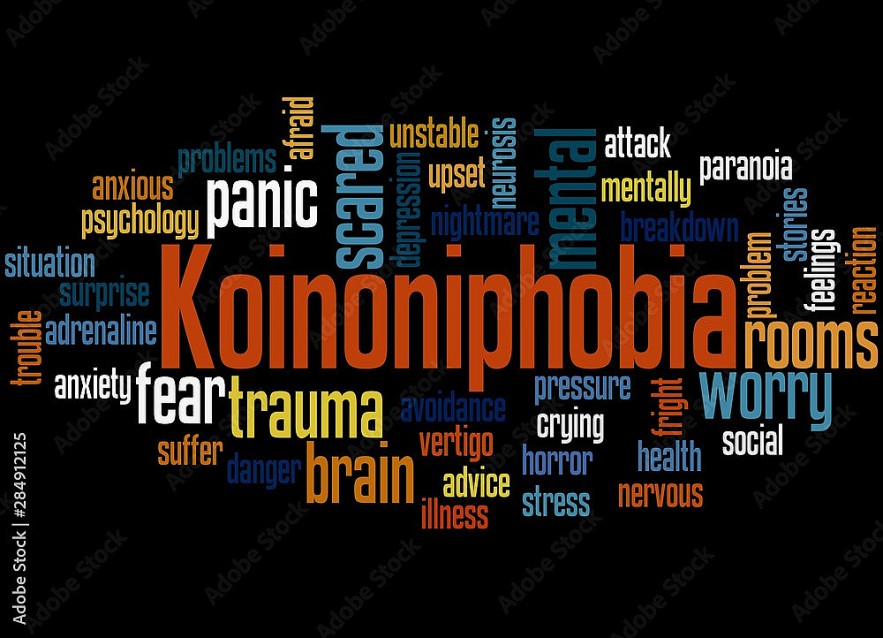 |
| Photo Adobe Stock |
Koinoniphobia is an intense fear of rooms. Sometimes this fear can be so overwhelming that the thought of entering a room can trigger an anxiety attack. Because rooms are virtually impossible to avoid, life for those with Koinoniphobia can be difficult to navigate. Some people with Koinoniphobia might avoid going to school so they don’t have to sit in a classroom full of other students. One of the ways to treat Koinoniphobia is through exposure therapy, which gradually exposes a person to their fear so that they can navigate life in a healthier way.
| Do I have koinoniphobia? Rooms are a part of everyday life, and other people are often in them. It’s natural to feel anxious about entering a room full of people you don’t know. You may also not like entering rooms where you don’t know what to expect. For some people, rooms cause an irrational fear that prevents them from completing once-simple tasks. If you have koinoniphobia, the thought of entering a room can bring severe anxiety. It can also cause overwhelming fear that leads to panic attacks. If you think you may have koinoniphobia, talk to your healthcare provider. Having an intense fear of rooms or rooms full of people can negatively impact your life because these situations are difficult to avoid. There’s no reason to feel self-conscious about having a phobia. Treatment can help you regain peace of mind. |
Symptoms: Constantly avoiding rooms, anxiety when thinking of rooms, panic attacks.
How to overcome:
A common treatment for koinoniphobia is exposure therapy. A therapist helps you become more comfortable being in rooms of people one step at a time. The first step may be discussing how different types of rooms make you feel.
As therapy progresses, you look at pictures, talk about situations and learn coping methods as you then gradually spend time in rooms with people. The first room may be with people you know. As you become more comfortable, you spend time in rooms with more people and with unfamiliar people.
| Is there anything I can do to prevent koinoniphobia? If you struggle with anxiety, there are steps you can take to reduce the likelihood of it worsening. Doing so can help you gain more control over your thoughts, lowering the risk of specific phobias. Steps you can take to manage anxiety include: Limiting alcohol and recreational drug consumption. Lowering stress. Quitting smoking and other forms of tobacco use. Spending time with loved ones. Taking up a new hobby to take your mind off the phobia. |
6. Chirophobia: Fear Of Hands
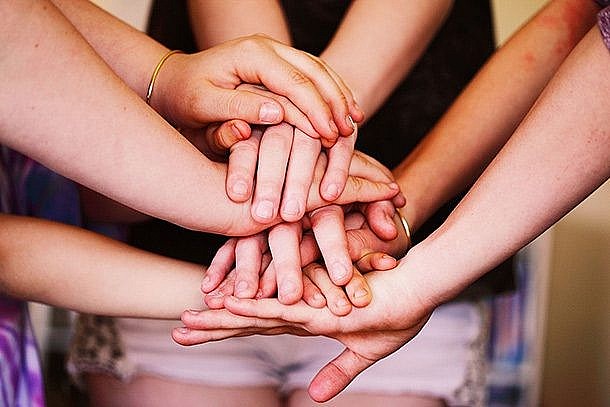 |
| Photo list 25 |
People with chirophobia — aka the fear of hands — that's who. This rare phobia can present as a fear of one's own hands or someone else's, but it's generally brought on by a traumatic experience, such as a hand injury or the onset of arthritis.
There are no definitive causes of chirophobia. Nevertheless, genetics and one’s environment may both play very significant roles in the development of this condition. For example, if someone has a family history of mental illness, especially of anxiety disorders or specific phobias, then they may have a higher chance of developing chirophobia. This may be due to them then having a genetic predisposition to developing mental illness in general.
Symptoms
- Anxiety when thinking of hands
- Constantly avoiding looking at people’s hands
- Unable to cope with their anxiety
- Muscle tension, shakiness, and sweating
- May experience panic attacks
How to treat
Dialectical Behavior Therapy (DBT) for Chirophobia
DBT is a very effective form of treatment for people struggling with emotion regulation. It is often used to treat people suffering from borderline personality disorder. Nevertheless, it can also be very advantageous for someone suffering from anxiety disorders like chirophobia too. This is due to the numerous amount of coping skills you can expect to learn in a DBT group. These groups typically last about 6 months long and can have anywhere from two people to several people depending on how many join the group.
Yoga for Chirophobia
There are numerous different yoga poses that can substantially benefit someone who is suffering from chirophobia. In part, this is due to the meditative state of mind that yoga tends to emit in those who practice it on a consistent basis. Yoga can be thought of as meditation in motion. It can help to relieve some of the anxiety associated with chirophobia due to the mere fact that by engaging in yoga, your attention will be redirected to something more productive.
There are many different types of yoga that someone with chirophobia can benefit from, such as hatha yoga or hot yoga, among many others. Nevertheless, regardless of the many different forms of yoga that exist, virtually all of them can help to relieve some of the stress and anxiety that is associated with chirophobia.
7. Venustraphobia: Fear Of Beautiful Women
Common Symptoms
Tachycardia.
Feeling of shortness of breath.
Excessive sweating.
Sickness.
Tremors.
Fear of losing control.
Sensation of disconnection from reality.
Venustraphobia is the one rare phobia on this list that sounds like it was made up by sitcom writers, but it is the very real fear of beautiful women. Of course, beauty is subjective, but generally those with Venustraphobia feel anxious around a beautiful woman, instead of enjoying the interaction like most others would. While it’s normal to feel butterflies on a date with a beautiful women, Venustraphobia can make people feel sick to their stomachs and they most likely wouldn’t even go on a date with a beautiful woman to begin with. In extreme cases, people with Venustraphobia can’t even look at or think about beautiful women.
How to overcome
Social skills training : In many cases the people who suffer this disorder is because they lack the appropriate abilities to deal with women and, Especially if they attract you.
The most used in these cases are the Antidepressant drugs (SSRIs) and Anxiolytics , Which can Serve as treatment for cases of extreme gravity.
However, numerous studies have demonstrated a greater efficacy of pharmacological treatment when it has been supplemented with psychological therapy, rather than In solitary. It is not advisable to use it during treatment with exposure techniques.
8. Eisoptrophobia: Fear of mirrors
 |
| Photo e-counseling |
There are no known causes of eisoptrophobia. However, genetics and one’s environment may play significant roles. Someone who has a family history of mental illness, especially with anxiety disorders and phobias may have a higher chance of developing eisoptrophobia.
This is due to their increased chance of having a genetic predisposition for developing mental illness. However, merely having a family history of mental illness is not enough to guarantee that someone will be genetically predisposed to develop mental illness. It is more complicated than this.
Symptoms
- Intense anxiety when around mirrors
- Anxiety when thinking of mirrors
- Unable to control intense emotions
- Avoiding mirrors and anything reflective
- Unable to rationalize their fear
- Muscle tension, shakiness, and sweating
| Types of mirror fear Fear of Mirrors and Body Image If you experience body image-related issues, the thought of mirrors or reflections may trigger a phobic response. You may also concurrently experience symptoms of spectrophobia, along with a feeding and eating disorder, and/or body dysmorphic disorder. Fear of Reflections A fear of mirrors may be related to a more generalized fear of reflections. In addition to mirrors, you may be afraid of any reflective material such as a highly polished car or some types of sunglasses. Reflections inherently distort the reflected items, causing them to appear slightly unreal, which some may find disturbing. Spiritual Fears Mirrors have long been linked to religious rituals, customs, and superstitions. Some believe that a mirror reflects a person's soul. In some cultures, individuals cover the mirrors in a newly deceased person's home, whether to prevent dead spirits from appearing or to keep surviving loved ones from being marked for death.5 The link between a mirror and the soul has led to a wide range of urban legends that may contribute to an individual's fear of death and/or ghosts. |
How to overcome
Psychotherapy is often an effective treatment option for people who experience symptoms of spectrophobia. Psychotherapy may be used in conjunction with medication or on its own. Therapeutic techniques will vary depending on your unique needs as well as your therapist's treatment style. Some common techniques used to treat specific phobias
9. Geniophobia: Fear of chins
Geniophobia is an overwhelming fear of chins. Yes, that innocuous body part attached to the lower part of your face! Further phobias of seemingly innocent body parts include genuphobia (fear of knees), chirophobia (fear of hands) and ishicascadiggaphobia (fear of elbows). As these phobias can make normal social interaction extremely difficult, treatment through therapy is highly recommended.
Symptoms: The symptoms of geniophobia can be quite varied but, at the same time, they are not difficult to identify.
These symptoms are also common among other phobias that involve fears towards other parts of the body, these symptoms can be: anxiety, excessive sweating, nausea, difficulty breathing and in some cases this can cause isolation and problems relating to other people.
It is said that the reason for this is that the affected person suffers from a wrong appreciation of the proportions of their own body and, on the other hand, it can also be due to a genetic pathology that involves the genes of chromosome 15.
How to treat
Due to the constant exposure to the trigger of this phobia, people’s faces, taking drugs to combat anxiety is not the best of treatments, since prolonged use of them can bring other side effects.
On the other hand, to treat geniophobia it is recommended to carry out psychological therapies or coaching where the exposure to the trigger is managed until the effects and symptoms caused by the affected person are reduced, some people also resort to treatments that involve hypnosis.
10. Amathophobia: Fear of dust
Amathophobia is a fear of dust.
Just like other phobias, Amathophobia does not have any common cause. Although, according to some scientists, your genetics and environment play a significant role in developing phobias most of the time. A family history of anxiety, disorders, and phobias may increase the chances of an offspring with similar issues.
Other causes of this fear may be a past incident where you had a bad experience with dust or witnessed someone else suffering due to it. It may also stem from another mental illness such as GAD or OCD. If you have been diagnosed with GAD or OCD, your fear of dust can just be an extension of this.
Symptoms:
Amathophobia can cause the following physical symptoms:
● Difficulty breathing
● Nausea
● Dry mouth
● A choking sensation
● Tightness in the chest
● Feeling like you will faint
● A rise in blood pressure
Amathophobia can cause the following psychological symptoms:
● Anxiety attacks
● Fear of losing control
● Anger, mood swings
| How to brush off Amathophobia (Self-Help Tips) ● Start sharing your fears with your loved ones ● Become aware of your feelings ● Partner up ● Practice breathing techniques Other treatments are seeking Professional Help, Exposure Therapy. During this therapy, as its name implies, the therapist will gradually expose you to the object of your fears over a period of time. |
11. Hippopotomonstro - sesquippedaliophobia: Fear of long words
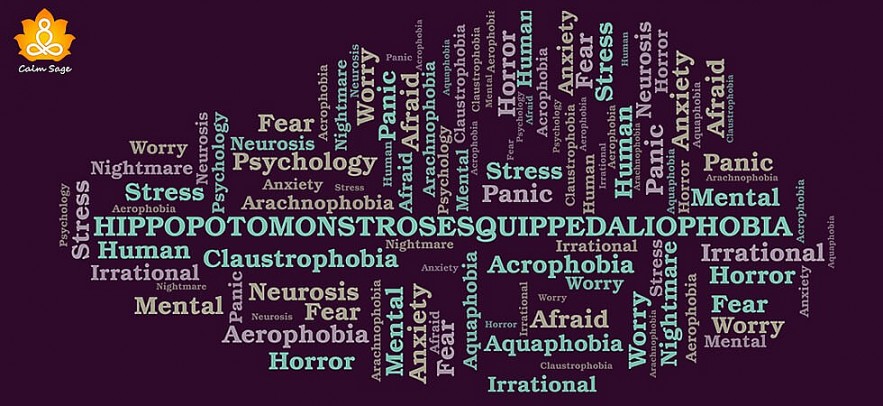 |
| Photo calm sage |
Hippopotomonstrosesquippedaliophobia is one of the longest words in the dictionary — and, in an ironic twist, is the name for a fear of long words. Sesquipedalophobia is another term for the phobia. The American Psychiatric Association doesn't officially recognize this phobia.
Symptoms:
Symptoms may be triggered when a person sees a long word, such as “antidisestablishmentarianism.” This can cause a person with hippopotomonstrosesquippedaliophobia to feel fear and anxiety. They may also avoid reading so they don’t have to come across long words that’ll cause them to panic.
Anecdotal evidence suggests that the fear of long words can trigger embarrassment or feelings of being mocked when pronouncing or reading long words.
Other symptoms can include:
- trembling
- sweating
- dizziness
- fainting
- dry mouth
- headache
- trouble breathing
- avoiding reading because of your fear
- feeling distressed over academics or work involving long words
There are also more general phobia symptoms that you could watch out for, including:
- being aware that your phobia is unreasonable, but feeling powerless to control your fear
- unable to function as you normally would because of your phobia
- feeling nauseated
How to treat
In general, a phobia can be treated in many different ways. Exposure therapy is the most common and effective form of phobia treatment. This version of psychotherapy helps change your response to the object, situation, or word causing you fear and anxiety.
Cognitive behavioral therapy (CBT) is another common form of treatment used to manage or cure a phobia. CBT blends exposure therapy with other therapeutic techniques in order to help you cope with your anxiety. It will also help limit any overwhelming thoughts.
Medications can also be helpful in managing anxiety disorders. However, not much is known about their effectiveness in treating this particular phobia.
Other treatment options include:
- talk therapy with a psychiatrist, counselor, or social worker
- mindfulness strategies such as mindful breathing, listening, and observation to help you cope with anxiety
- attending a support group to connect with other people facing the same or similar phobia
12. Phobophobia: Fear of fear itself
Like all phobias, phobophobia is an exaggerated fear response. While in other phobias, the irrationally heightened response focuses on a specific object or situation, in phobophobia, the fear is of the fear response itself. Phobophobia is condition rooted in underlying vulnerabilities to anxiety. If you are already limited by a phobia, it's not difficult to imagine a fear of developing additional ones.
Symptoms
Like all other phobias, the main symptom, intense and irrational fear of the said things, remains common. In this case, there is an irrational yet intense fear of fear itself. To recognize phobophobia in yourself or your loved one, you need to watch out for these symptoms;
- Chest pain
- Trembling
- Chills
- Dizziness or lightheadedness
- Nausea
- Breathing issues
- Excessive sweating
- Intrusive thoughts
How to overcome
To overcome phobophobia the first thing you need to do is visit a mental health expert. No mental health condition can be overcome without proper professional guidance. If you have found yourself a victim of phobophobia, just relax and meet your doctor.
Once you have been diagnosed with phobophobia, you can either opt for therapy, medication, or both. You can sit with your doctor and choose the right treatment plan to overcome phobophobia.
When it comes to therapy, exposure therapy, behavior therapy, cognitive behavior therapy, etc work best for phobophobia. In some studies, it was proven that carbon dioxide exposure can also help in reducing the symptoms of photophobia.
Talking of drug treatment for phobophobia, there is not much use of medications. However, in some severe cases, drugs like beta-blockers and sedatives can be prescribed for temporary relief.
Now, while you are undergoing treatment for phobophobia, you can make some lifestyle changes to speed up the process. Such as;
- Indulge in meditative practices
- Yoga can help your body relax
- Be as active as possible
- Spend more time outdoors
- Practice breathing exercises
13. Urophobia: Fear of urinating
Symptoms
Urophobia is a kind of anxiety disorder. The most significant symptom in all anxiety disorders is anxiety while being exposed to the fear stimulus.
Fear stimulus is anything that can trigger anxiety. In this case, the fear stimulus is urine itself, or the thought of it.
The second most significant symptom in anxiety disorders is avoidance from the fear stimulus. Hence, Urophobic people will avoid urine anywhere, any time.
Avoidance can lead to a cycle of maintaining the condition.
Because as patients avoid the fear stimulus, they experience a false sense of security which can increase the fear and anxiety they undergo. so, avoiding urination can just make the symptoms more severe.
Panic attacks can be seen in severe forms of urophobia, and if they occur the patient would need to be hospitalized. However, this is not the case for everyone suffering from Urophobia.
In addition to the mentioned symptoms, DSM-5, which is the diagnostic and statistical manual of mental disorders, suggests some symptoms by which urophobia can be diagnosed.
These symptoms should last for at least 6 months, and 3-5 of the following symptoms must be seen in the patient.
Treatment: Mindfulness-Based Stress Reduction (MBSR)
This is a kind of group therapy in which patients are taught some meditation techniques.
For example, they are told to focus on their breathing rhythm, inhale and exhale. This way, they would be distracted from the stressing trigger.
This kind of therapy usually lasts for 8 weeks. To boost the patients’ treatment, sometimes they are given some homework.
Like yoga and meditation practices, then they have to record the thoughts and feelings they experienced during the meditation.
How should you deal with a phobia?
Exposure therapy is by far the most effective way to deal with a phobia. “It involves gradual confrontation of the thing you’re afraid of,” says Wolitzky-Taylor. “The basic idea is to disconfirm a person’s belief about what will happen.”
So let’s say you’re afraid of dogs. Exposure therapy might involve standing in a room with a dog, and then gradually moving closer to it and, eventually, petting it, she explains. Meanwhile, you’d be talking with your therapist about what exactly you’re worried about—say, the dog biting you or jumping on you. The therapist would point out that these fears aren’t coming to fruition, which would help recondition you to feel less fear.
“Sometimes negative things happen, and it can actually make therapy more effective,” Wolitzky-Taylor says. She explains that usually these events—the dog jumping on you—aren’t as bad as your mind thought they would be. So that negative experience actually helps shrink your fears down to size.
Conclusion
Everyone is afraid of something, but when the fear becomes too intense and disruptive, a phobia can develop. Phobia is part of our daily life. If you have some of the symptom above, don't worry. We have advice on how to overcome it. Phobia is not fearful and can be treated. Try cognitive behavior therapies or simply yoga for treatment.
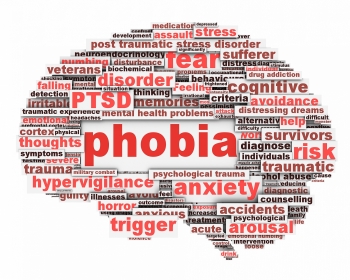 Top 20 Weirdest Phobias You Might Not Have a Clue Top 20 Weirdest Phobias You Might Not Have a Clue Fear is a natural response to danger, phobias often occur in response to something unlikely to cause real harm. Check out the top 20 weirdest ... |
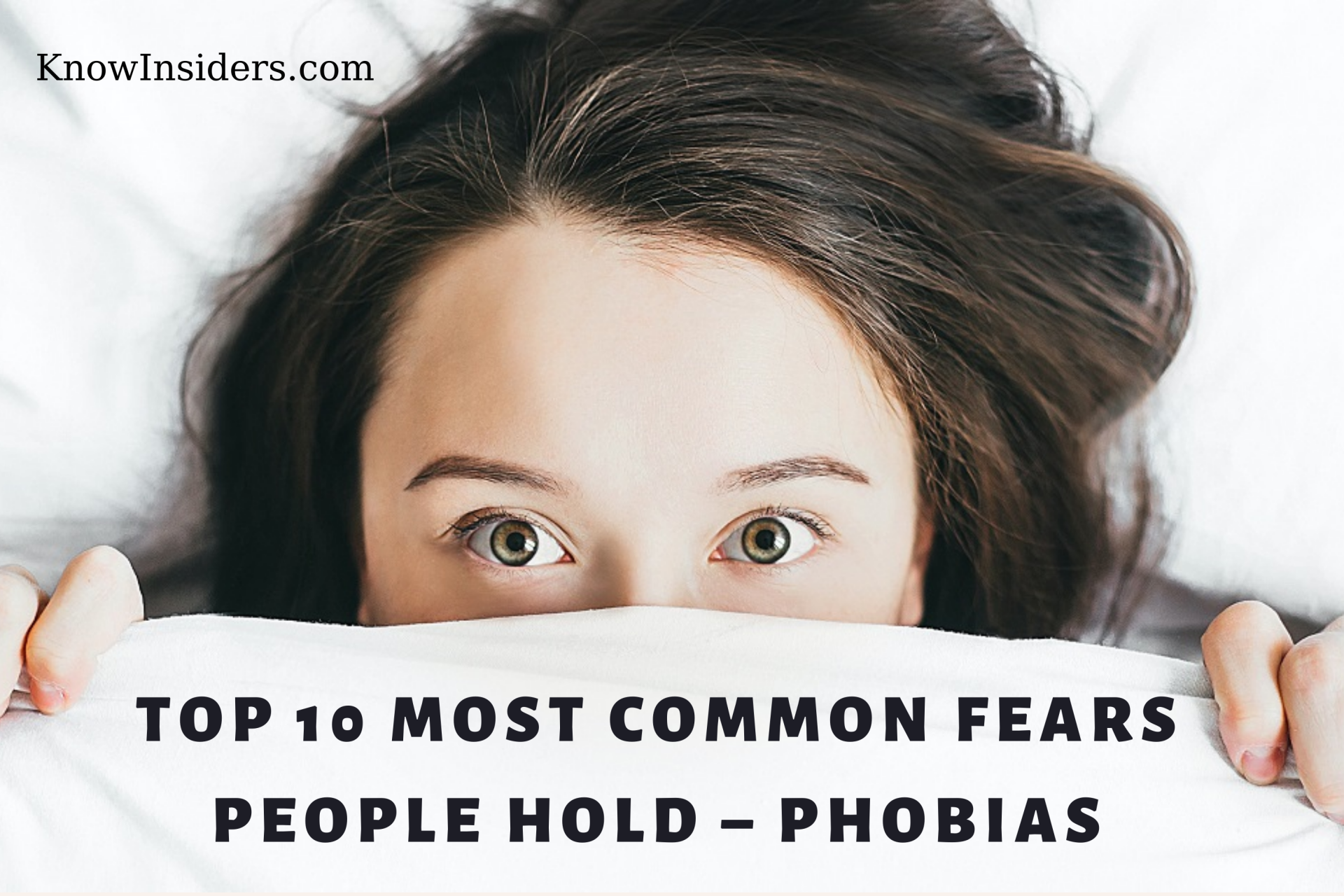 Phobias - Top 10 Most Common Fears People Hold Phobias - Top 10 Most Common Fears People Hold Phobias are distressing emotions initiated by out-of-proportion fears, both real and imaginary. Check out Top 10 Most Common Fears People Hold – Phobias right below! |
 Top 4 Zodiac Signs Have The Biggest Monophobia - Fear Loneliness Top 4 Zodiac Signs Have The Biggest Monophobia - Fear Loneliness Does loneliness scare you so much that you want to find someone immediately to keep you company? If the answer is yes, you are one ... |
























